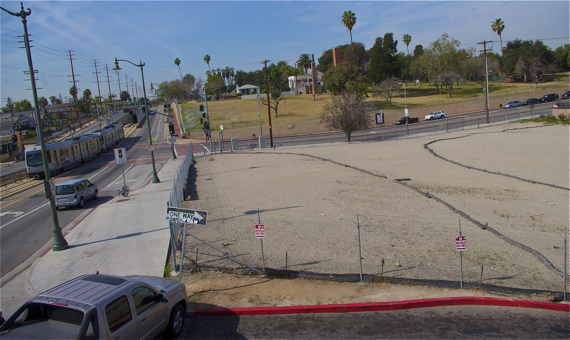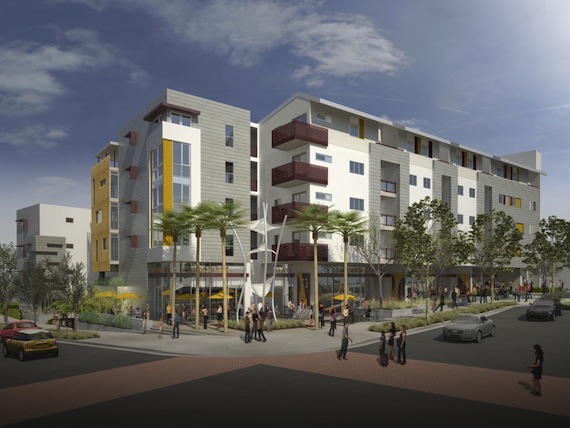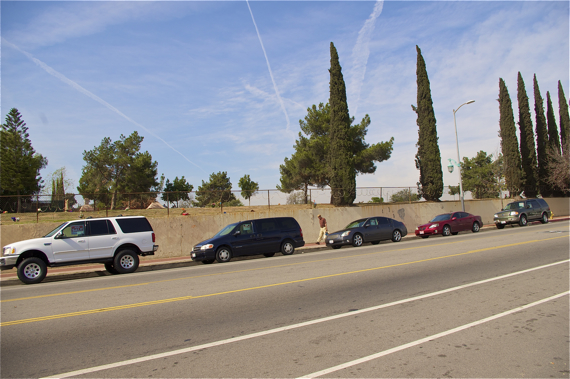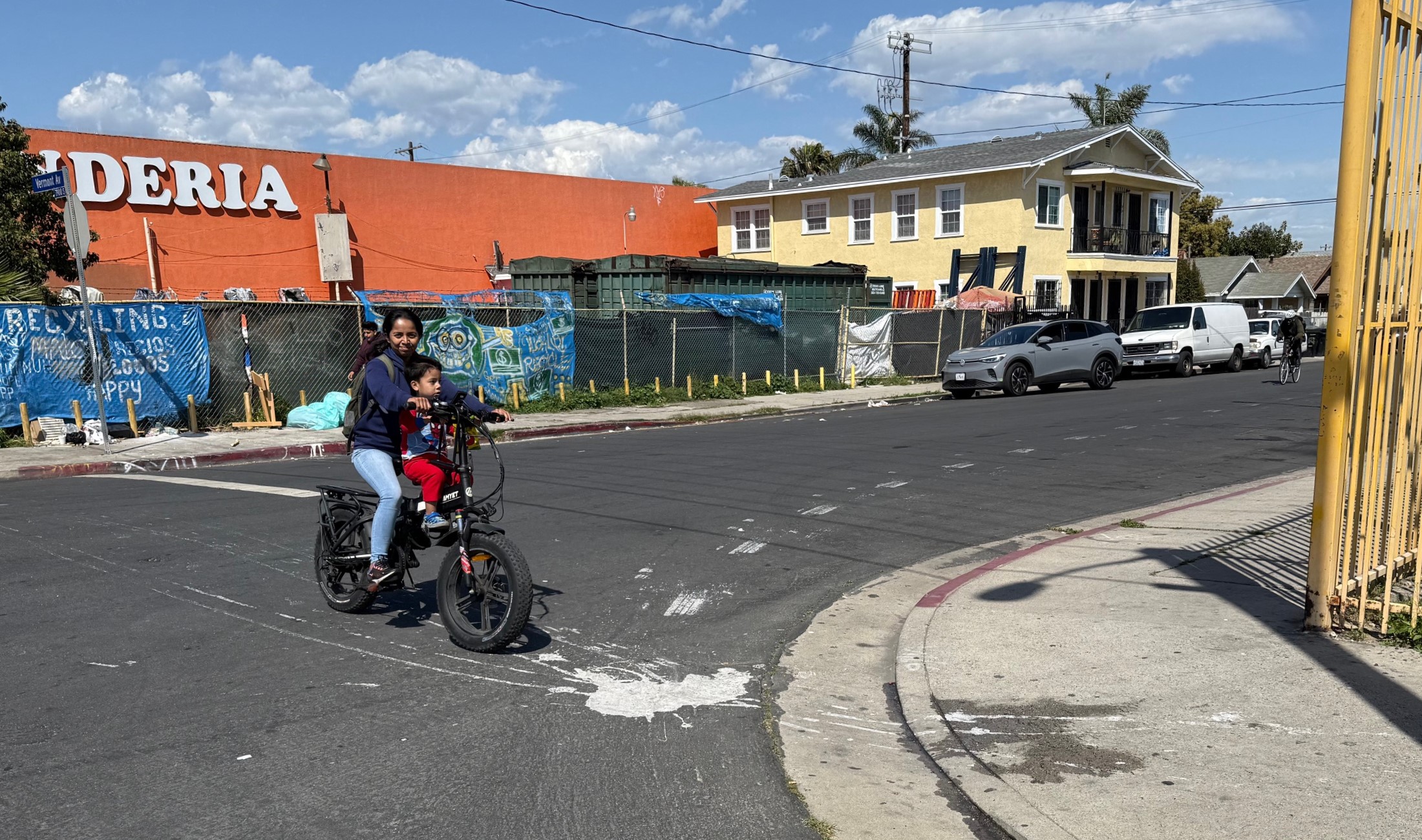
What had ever happened to the plans to turn the space on the corner of Lorena and 1st St. into a fitness parklet?
Many of those gathered this past Wednesday evening at the second informational meeting regarding the plans for the site were still feeling burned by the promise they believed Metro had reneged on to put a park there.
At another meeting on the subject back in December of 2012, Metro had essentially told the community it had chosen a mixed-use development project because it was working toward enhancing transit quality and was not in the business of building parks. Last week's informational meeting on the plans for the site had only reaffirmed that the park plans were out of the question.
Still, it wasn't a dream people were willing to give up on just yet.
A mini fitness park would have been a wonderful addition to the jogging path that runs around the (not so) Evergreen cemetery across the street, lamented Rita Govea Rodriguez, a long-time Boyle Heights community stakeholder. Citing other examples of well-used fitness zones from around the city, she said it was something that her community would really have benefited from.
We were discussing the progress of A Community of Friends' (ACOF) plans to build a four-story building containing 49 affordable housing units -- half of which would be reserved for people with special needs (e.g. the homeless or mentally ill) -- and approximately 7000 sq. ft. of retail space at the Lorena site.
The $23.1 million project cleared its last hurdle last March, when the Metro Board voted 10 - 1 to begin negotiations with ACOF regarding the development.
Jose Huizar, Councilmember for the 14th District and (now a former) Metro Board member, was the lone dissenting vote at the time. He was concerned that the drastic reduction in retail and parking space from the original 2006 proposal would heavily curtail the boost in economic activity the project was expected to have generated in the surrounding areas.

The community members present at the informational meeting on the project held at YouthBuild Boyle Heights this past Wednesday had an entirely different set of concerns on their mind. And, they weren't shy about loudly telling ACOF CEO Dora Leong Gallo again and again, "You're not welcome here."
The most common concern was that the project would not benefit Boyle Height residents.
While the stakeholders gathered acknowledged the area has many needs -- affordable housing and resources for those with special needs being chief among them -- they did not buy the claim that Boyle Heights residents would actually have access to the housing units.
When Gallo tried to reassure the community members that they would be kept well-informed about the progress of the development so they could be the first to apply for housing, she was roundly shouted down.
Nadine Diaz, an M.S.W. and a Recruitment Coordinator with USC's Alzheimer's Disease Research Center, said she lived practically next door to the Lorena parcel and ACOF had failed to inform her and other stakeholders about the informational meeting.
How could they be expected to trust that the process would be more transparent going forward?
Regardless of the answer, Diaz and the other neighbors (who also hadn't been informed about the meeting) weren't particularly inclined to put their trust in either Metro or ACOF anyways.
ACOF, Diaz charged, hadn't done basic asset or deficit mapping in the area and seemed to know little about the community. And, as someone who works with those suffering from mental health issues herself, Diaz said she was concerned that the apparent lack of plans to have on-site qualified care-givers and resources to ensure the residents' medical needs were properly addressed could bring harm to both those residents and the surrounding community.
Gallo, looking slightly flummoxed at the disruptive turn the discussion had taken, repeatedly attempted to both calm and reassure the crowd, saying, "I think there's a misperception about who is going to be in this building...or [about] what supportive housing is..."
It was a plea that fell on largely deaf ears.
One young woman said she had seen ACOF's housing facility in San Diego firsthand and was not impressed by the deterioration of the conditions of the surrounding area or the heavy presence of homeless people loitering around the site. She did not want that for her neighborhood, especially if the housing was not even going to serve people in the community.
When Gallo tried to tell her that they only built that San Diego property -- they did not operate it, the crowd became more agitated. Gallo seemed to be confirming their fears that ACOF might wash their hands of the structure once it was built.
The operators would then be free, warned a stakeholder, to turn it into a drug rehab facility or promote some other use which was not in harmony with the surrounding neighborhood.
That would not happen, countered Gallo.
The discussion swung back to who would benefit from the housing.
Resident Fanny Ortiz stood up to say that, as the mother of a special needs daughter and as someone who had once been homeless herself, she welcomed the project.
"Who do you work for?" demanded property-owner and resident Teresa Marquez.
When she admitted she worked for Metro and was a volunteer with ELACC (the East L.A. Community Corporation), an organization that has converted a number of properties in the area into affordable housing and is seen by many as not having the interests of the community at heart, the crowd went ballistic.
"Sit down!" the crowd yelled at her.
Gallo implored the crowd to let the woman speak.
Other audience members accused the woman of being with the enemy and told her that, if Metro was paying her salary, they had heard all they needed to hear from her.
The woman forged ahead, saying she felt that such a project was necessary for people in the community like herself and her daughter.
"But [the housing] will not be for you!" argued a young woman, reiterating her belief that the housing would go to people from outside the community.
An exasperated Gallo pleaded for respectful dialogue and tried to again reassure the crowd that ACOF would take care to look for those in need on the streets of Boyle Heights while also working with local organizations to ensure they targeted the right people.
"Be careful who you work with!" warned Sofia Quinones.
Launching into a passionate and, at times, tearful speech mixing Spanish and English, the woman spoke of how she felt the community had been burned by organizations like ELACC in the past.
Citing the renovation of the Boyle Hotel (once home to the Mariachi community) and the empty promises made to those that once lived there, Quinones proclaimed, I hate them, the bastards! They treated us like dogs!...I was here when they threw out the the Mariachis... They cut off their water, their electricity... They always treat Mexicans this way!
They want to get rid of the people of Boyle Heights. Then the high rents will come!... The writing's on the wall...
Turning back to Gallo, she said, "Be careful who you work with. You're going to work with organizations that have hurt us...I'm asking you again, sister. Leave."

Besides gentrification, a number of people feared over-crowding.
The presence of El Mercado de Los Angeles -- an important cultural space, restaurant, and marketplace -- means parking in the area is already scarce.
That situation is made worse by the person (or people) running an informal car dealership on the nearby side streets. The vehicles up for sale tend to be clustered around El Mercado because of the heavy foot traffic going in and out of the area. Several speakers noted that it is even worse on the weekends (which means it is truly untenable; I personally counted 16 out of the 39 parked cars on Lorena as being for sale Thursday afternoon).
Such a large housing structure, added Diana Tarango, a third-generation Boyle Heights resident, would also be joining several others going up in the neighborhood (including an ELACC-owned structure on the other side of the cemetery). The neighborhood was becoming overwhelmed with these large housing projects, most of which did not seem geared at serving the immediate community.
Addressing Gallo directly, she asked if Gallo would like to see that happening in her neighborhood.
Finally, a young man stood up and pleaded for calm.
Citing environmental concerns, he said that the ecosystem was being asked to sustain too much activity. He also spoke of his fears for the safety of the mentally ill residents, saying that they might either walk in front of the train by accident or get taken advantage of by less scrupulous people in the neighborhood.
After again pleading for more measured dialogue from the spirited crowd, he returned to the point many had made throughout the night, namely, that ACOF should work to prioritize the needs of the people in the community before serving the needs of those from outside it.
"That young man...is my son," Govea told me as we watched Gallo and other staff gather some of the folding chairs ACOF had borrowed for the event when the meeting finally came to a close a little after 8 p.m.
Many in the crowd, animated by having gotten their point across and having found like-minded neighbors, continued the conversation outside..
Discussing the young man's plea for civility, they wondered if it really mattered. The debate over the future of the site at 1st and Lorena had been going on for years, and they were frustrated by the likelihood that their input -- civil or otherwise -- would have little impact on the final outcome.
Hoping for the best, they declared they would take to social media. It didn't mean they would win the battle, they understood, but it did mean they would not go down quietly.
For more information on the planned development, please see ACOF's plans here.






